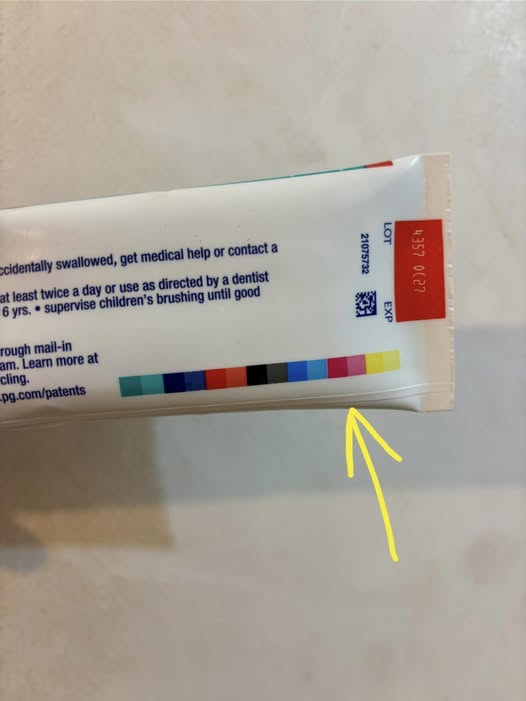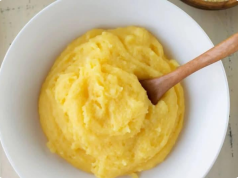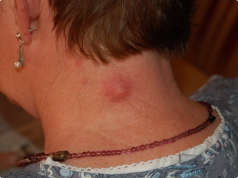If you’ve ever squeezed the last bit of toothpaste from the tube and noticed the small colored rectangles — green, blue, red, or black — printed along the crimped end, you’ve probably wondered:
👉 What do they mean?
You’re not alone.
For years, a popular internet myth has circulated, claiming these little squares are a secret code that reveals the truth about what’s inside your toothpaste:
- Green = all-natural ingredients
- Red = mostly natural, with some chemicals
- Blue = natural with medicine
- Black = 100% chemical
Sounds like a clever insider tip, right?
Spoiler alert:
❌ It’s not true.
There’s no secret ingredient decoder on your toothpaste tube.
No color-coded manifesto about chemicals vs. nature.
So what are those colored squares?
Let’s uncover the real — and surprisingly simple — truth.
🧩 The Real Purpose: Printer’s Marks, Not Ingredient Codes
Those little colored boxes are called printer’s color blocks — also known as registration marks.
They’re used during the manufacturing and printing process to ensure the packaging is printed correctly.
Here’s how it works:
Toothpaste tubes are printed using multiple layers of ink — typically the CMYK color model:
- Cyan (blue)
- Magenta (red)
- Yellow
- Black
These colors are applied in separate stages, and even a tiny misalignment can result in blurry, crooked, or smudged designs.
To prevent this, machines use the colored registration marks as alignment guides.
Sensors on the production line scan these marks to make sure:
- The text is straight
- The logo is centered
- The colors are perfectly layered
- The tube is cut and crimped in the right spot
Think of them as digital rulers — invisible to most consumers, but essential for quality control.
🔍 Why the Myth Spread
The idea that the colored squares reveal ingredient secrets gained traction in the early 2000s through chain emails and social media posts, fueled by growing concerns about:
- Chemicals in personal care products
- Transparency in labeling
- Hidden ingredients
People wanted a simple way to “read between the lines” — and the colored squares seemed like a perfect clue.
But here’s the catch:
👉 The same colors appear on all types of toothpaste — natural, conventional, medicated, and whitening formulas — regardless of their ingredients.
A green mark doesn’t mean the toothpaste is organic — it just means the printer used a green guide.
🛠️ Fun Fact: The Color Doesn’t Matter
The color of the mark (green, red, blue, etc.) is completely arbitrary.
Manufacturers choose them based on:
- Contrast with the background (so sensors can detect them)
- Ink availability
- Design layout
There’s no standard, no code, and no industry-wide meaning.
Some brands use two marks — one for the front, one for the back — to align both sides of the tube.
✅ How to Actually Know What’s in Your Toothpaste
If you want to understand what’s inside your toothpaste, skip the colored squares and check:
- The ingredient list on the back
- Certifications (like “Natural,” “Vegan,” or “Cruelty-Free”)
- Third-party seals (e.g., ADA approval, EWG Verified)
- Brand transparency — reputable companies disclose their formulations
And remember:
- Fluoride is safe and effective for preventing cavities (unless you have a rare sensitivity)
- “Natural” doesn’t always mean safer
- Always consult your dentist if you’re unsure about a product
🧼 Final Thoughts: Sometimes, It’s Just Packaging
The colored squares on your toothpaste tube aren’t a secret.
They’re not a conspiracy.
They’re not a code.
They’re just part of the printing process — a behind-the-scenes detail that ensures your toothpaste tube looks clean, professional, and perfectly printed.
So the next time you see that little green or red box,
👉 Don’t overthink it.
It’s not telling you about chemicals.
It’s just helping the machine do its job.
And as for what’s really in your toothpaste?
👉 Read the label — not the myth.
The truth is simpler than the rumor — and that’s a good thing.










